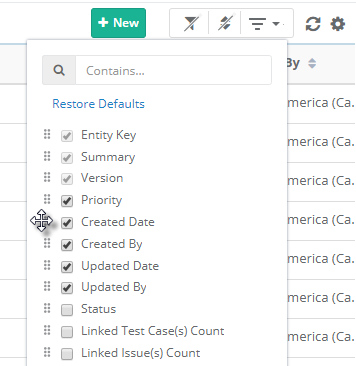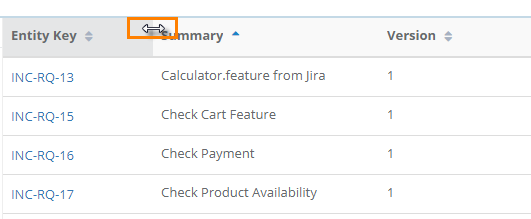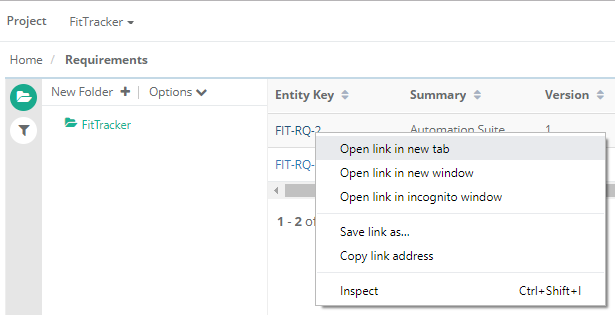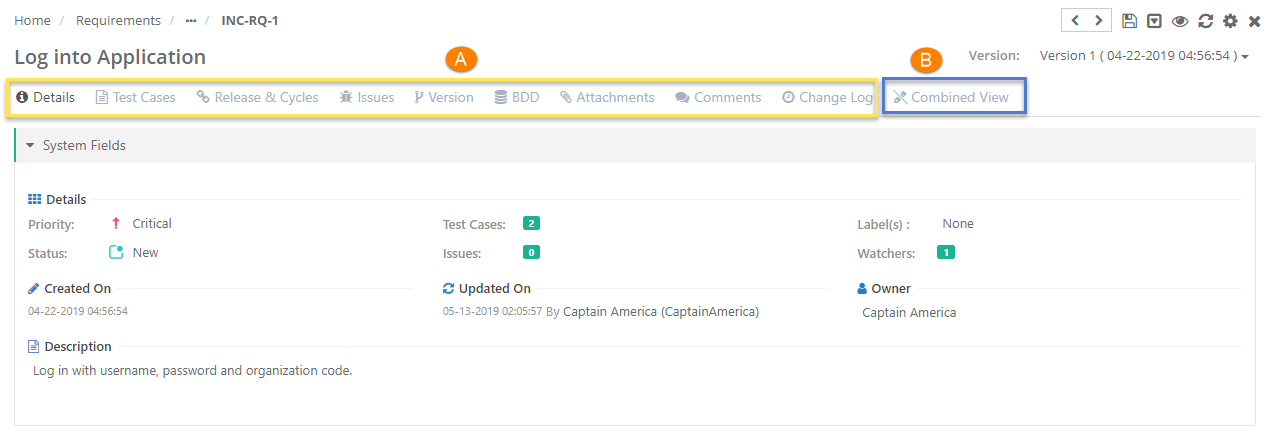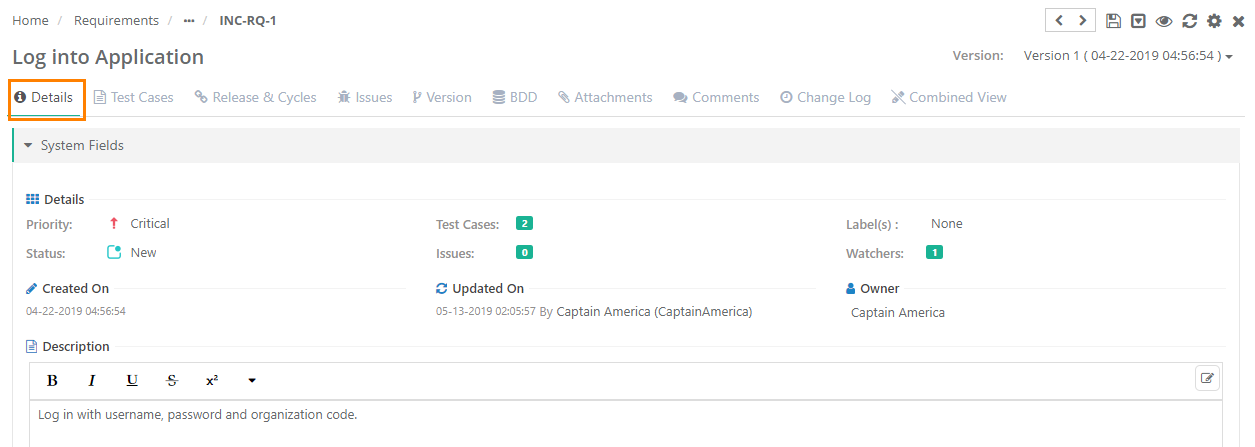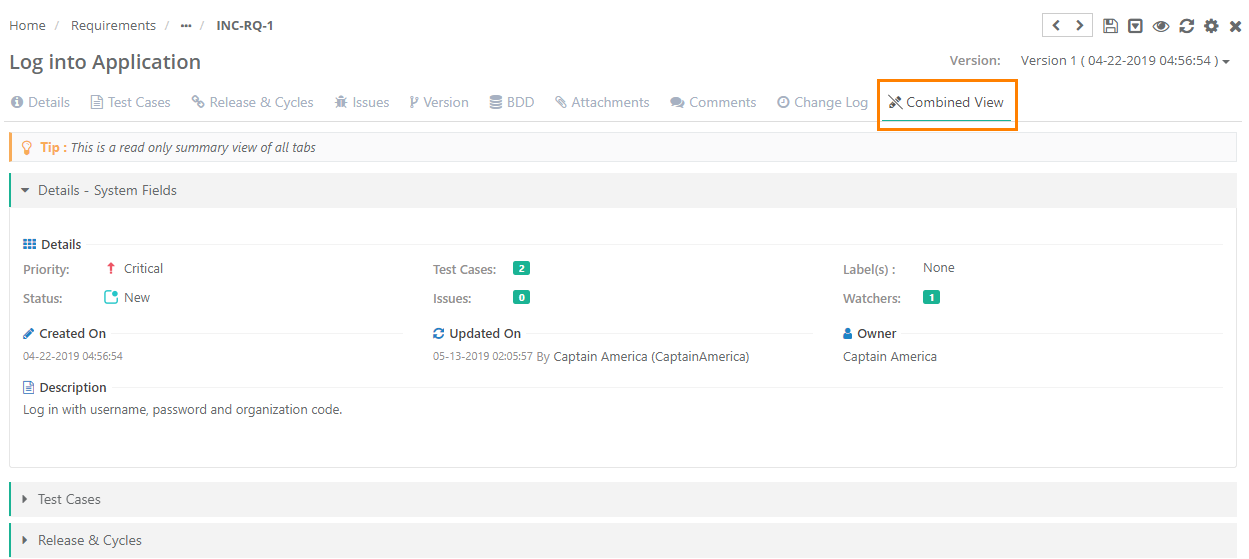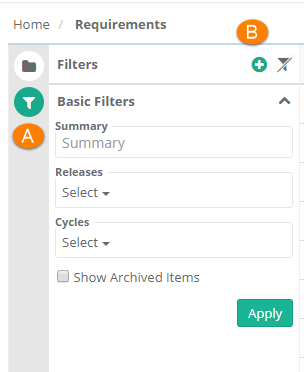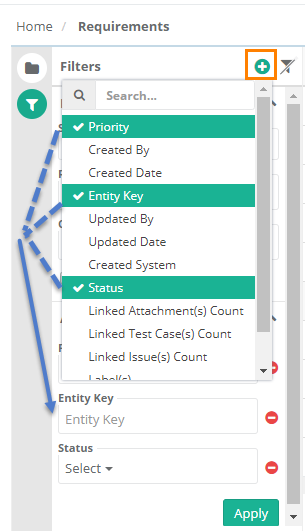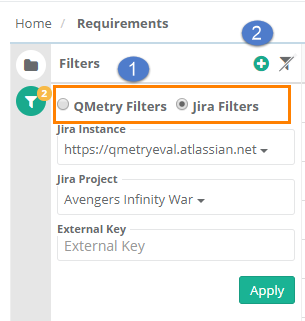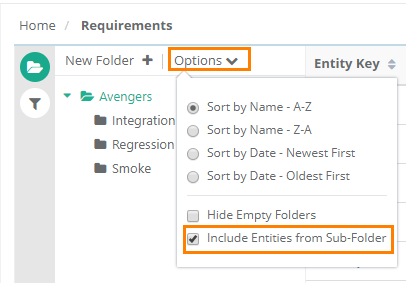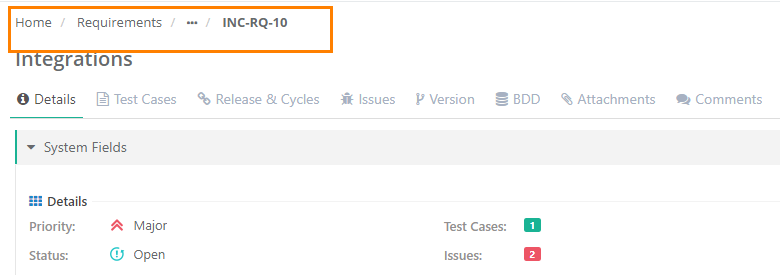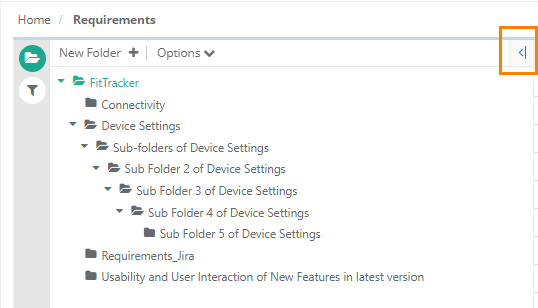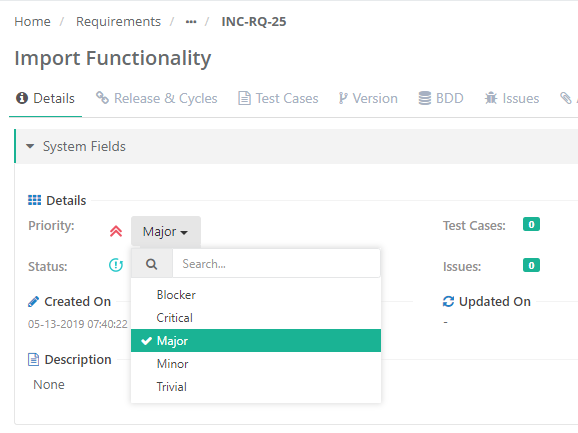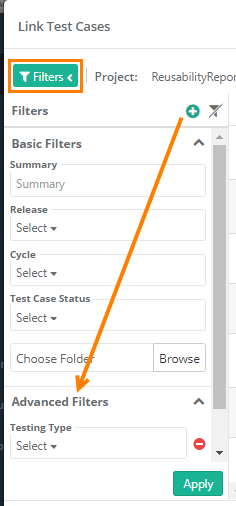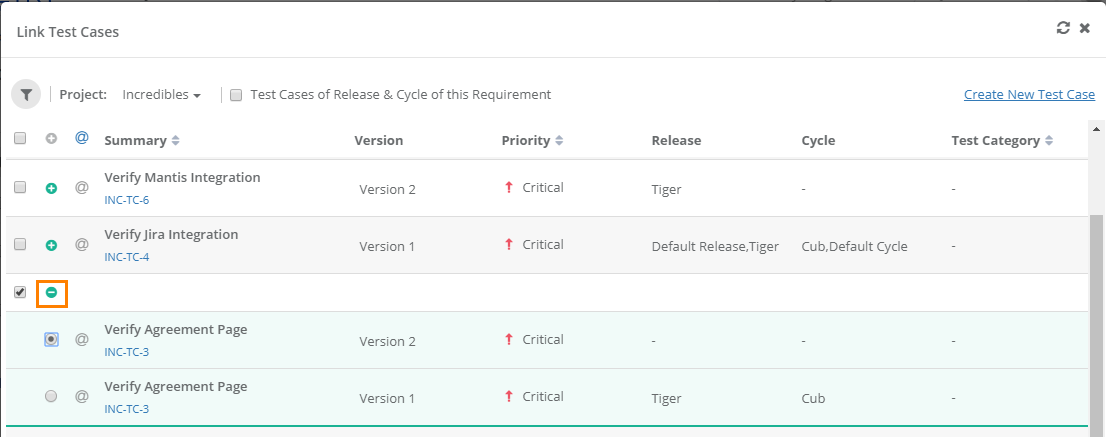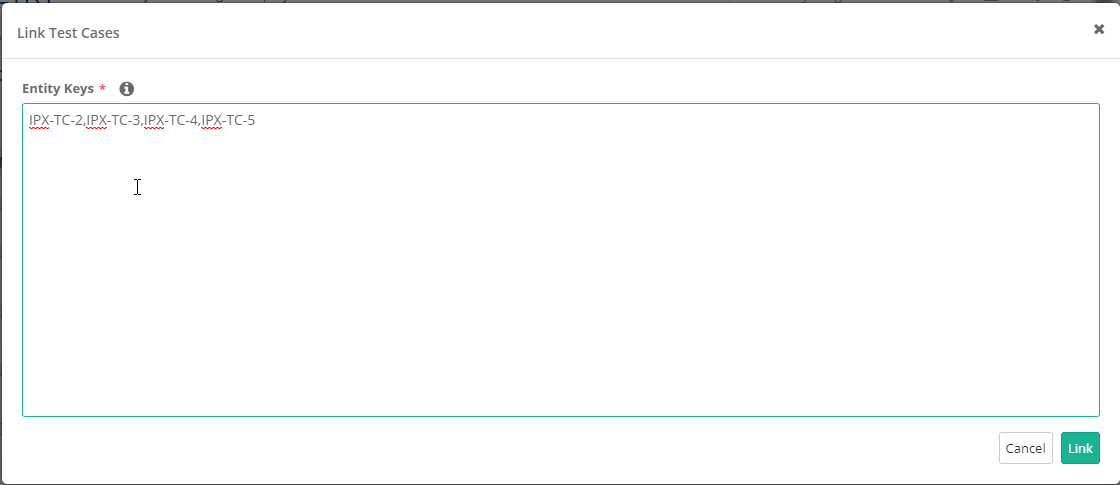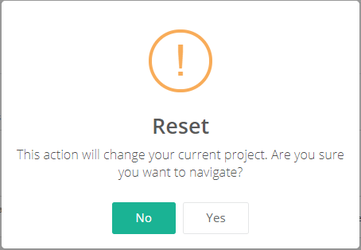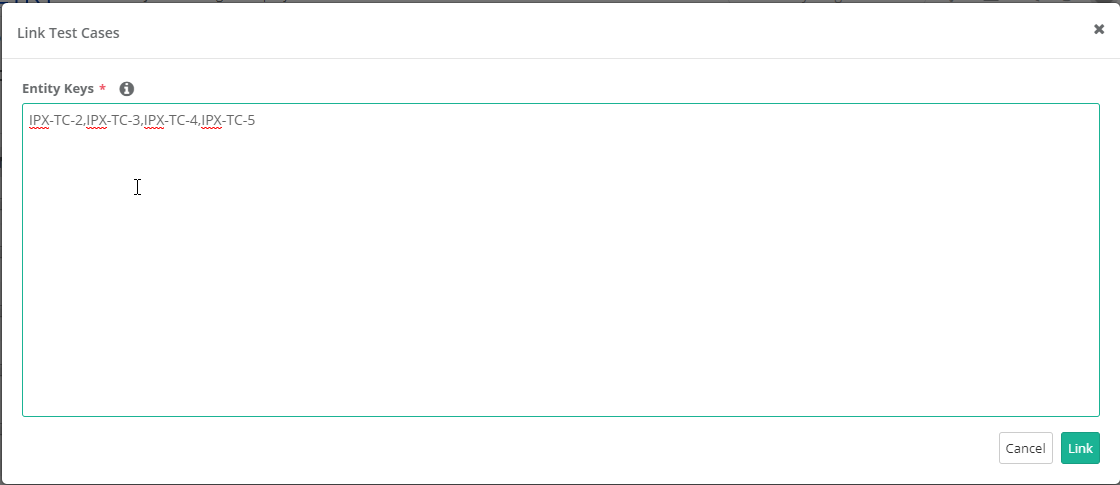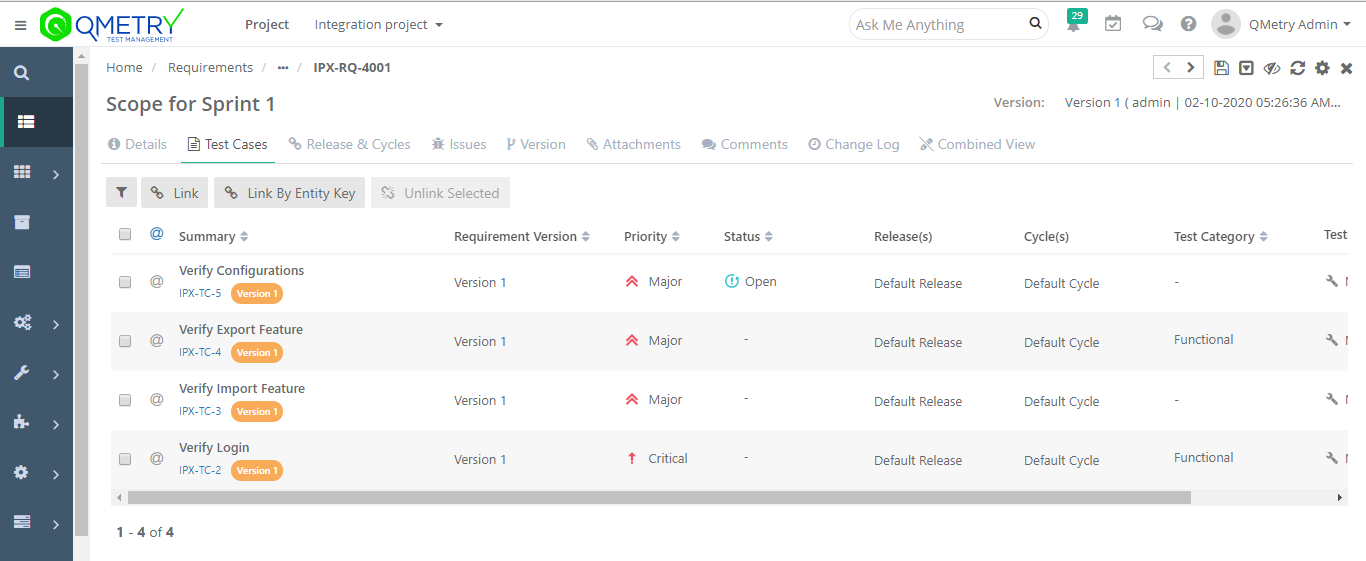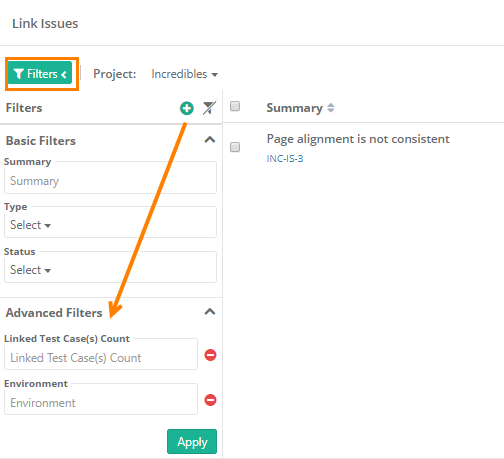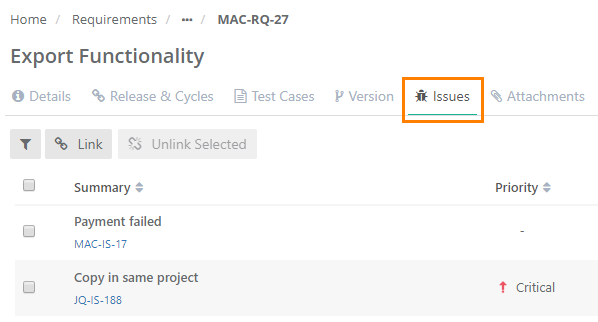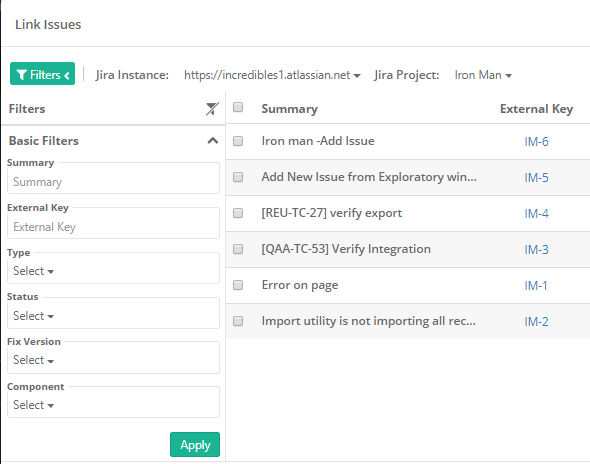Organizing Requirements
The Requirements module serves as a central repository to store test requirements or business specifications. You can create requirements manually, or import using excel using import wizard or from Jira.
Once requirements have been imported, existing test cases can be linked to the requirement.
With the Requirements module you can:
- Add requirements based on requirements from external development and product management tools. Requirements can be created directly from Jira and kept in sync with Jira.
- Cover requirements by linking them to existing test cases which are part of manual or automated test suites.
- Perform quick ad hoc executions of test cases associated with a particular requirement. This can help you do quick tests based on pure requirements that might not be covered in a defined test suite.
Requirement reports are also available to analyze the application against varied measures.
Requirement Window
The Requirements module screen has the following UI.
Manage Grid Columns
All grids within Requirements, Test Cases, Test Suites, and Issues module have Arrange Columns option that allows users to create a customized view of their test assets.
The view is saved for future use.
The following customization can be applied:
- Show More Columns: The ability to add columns in view. If there are other columns that you think important to display on the module grid apart from the default view, then you can just select those columns to add them to the view.
- Hide Columns: The ability to remove a column from view. If you do not want to include columns of less important on the module grid view, then remove column selection to hide those columns on the view.
- Re-arrange: The ability to arrange the columns in a different order through drag and drop functionality.
You can search for a particular column through the search box.
- Resize Columns: The ability to expand and reduce column width. If you want to display the full content of the column, then you may want to change the column width. To change the width of one column, just place cursor in between the columns and drag the boundary on the right side of the column heading until the column gains the width that you want.
Requirement Detail Page
Just click on the Requirement Key in the grid view to open the requirement detail page on the same page.
To open the requirement detail page in new tab/window, right click on the Requirement Key in grid view. Opening requirements in different tab/browser makes comparison between requirements easier. It also provides quick reference while working on multiple assets.
The detail page is redesigned that allows one click access to different sections using organizable tabs.
Organize Tabs
The detail page of QMetry assets has different tabs on it as described above. Users can customize the view of detail page by changing the order of tabs. The tab order is preserved per user.
For example, the tab order of Requirements module is changed by user "A" for project "PRO1". Now "A" is switching to another project "PRO2". The tabs can be seen in the same order as in project "PRO1".
Combined View vs. Grouped View
A. Individual Section Tabs
B. Combined View (Read Only View)
A. Individual Section Tabs
For Requirement: There are individual tabs for Details, Test Cases, Release & Cycles, Issues, Version, BDD (if configured), Attachments, Comments, Change Log.
Each tab displays relevant details. The details of the tabs are editable.
B. Combined View (Read Only View)
The tab renders the old view of details page. You can view the details of all the section on a single page. The details displayed on the page are read-only and it can not be edited.
The Previous and Next buttons on the detail page are added for ease of navigation and updation of requirements.
Filter Requirements
Users can easily filter test assets by any system/custom fields on all module grids. It also helps users in carrying out bulk operations. Filters placed horizontally above the grid earlier, are now placed on the tree panel at left.
Testers can view details grid aligned with folder tree even when they are clicking a folder which is at the bottom. It displays top of the screen instead of bottom of the screen.
Apply Filter
Users can apply basic as well as advanced filters to the records.
A. Basic Filters: By default, basic filter fields are provided to filter the records.
B. Advanced Filters: If users need more fields to filter test assets then click on the '+' icon. It opens the drop-down with a list of additional system and user defined fields corresponding the module.
Select the field you want to apply filter on. The filter parameter is added as Advanced Filters. Apply filter as per your requirement.
For example,
Users want to filter test assets on Priority, Entity Key and Status, then click on the '+' icon and select the fields on the drop-down list as shown below.
Apply Filter when Jira is Configured with Project
If QMetry project is synced with at least one Jira project, then only Jira Filters will be enabled for Requirements module. Two distinct filters: QMetry Filters and Jira Filters options are available filter requirements. Select either of them. If you want to apply Jira Filters, first select –
- Jira Instance and Jira Project with which the QMetry project is configured and click Apply. If you have only one Jira Instance and Project configured with your current QMetry project, the instance and project will be auto selected.
- Once this filter is applied, you can see more filter by clicking on + button.
The filter applied on the records will be preserved and rendered again when you visit the screen next time.
Jira fields, on which you filter the records, do not appear on the Requirement list view. e.g., Fix versions.
Clear Filter and Sorting
Users can clear the applied filter and sorting to the records.
A. Clear Filter: Click on the Clear Filters button above the module grid or on the left pane. It will reset the view to default.
B. Clear Sorting: Click on the Clear Sorting button above the module grid.
Choose to include/exclude Requirements from Sub Folders at Parent Folder
Users can opt to include or exclude test assets from sub folders at parent folder. By default, Include Entities from Sub-folder remains selected, and entities from sub-folders are displayed at parent folder level on the module list view.
To hide the entities from sub-folder, open the Options drop-down on the test asset tree at left, and select deselect Include Entities from Sub-Folder.
Navigation
Once you are on the requirement details page, you can go back to the main screen of requirement by clicking on the breadcrumbs.
The Requirements module main screen displays requirements in the Project as per folder selection. You can apply filter to the columns as mentioned above. Multiple columns can be filtered at once to help users find the required requirements.
Managing Requirement Folders
User can categorize different requirements and create different folders to put them. User can add new folder to the root or as a child of an existing folder.
Use Case: The organization has received bulk amount of project related requirements from its client. To manage these requirements, they need to be categorized. Requirements of similar category are added to individual requirement folders.
Adding a Requirement Folder
Open the Requirements module. The tree/folder panel is expandable that facilitates stretching of the area if you want to view longer folder names. You can also hover over the folder to view its full name.
On the Requirement tree, click on the New Folder button to add a new folder.
The Add New Folder pop-up opens.
Enter the following fields to add a new folder:
- Folder Name: Enter name of the folder.
Click Create. The new folder is reflected on the tree.
Note: The following permissions related to the Requirements module are set from Customization > Roles for individual roles.
- View
- Modify
- Create
- Delete
- Import
- Export
- Link
- Copy
- Versioning
Make sure you have relevant rights to carry out the operation.
Editing a Requirement Folder
Select the folder on tree and click on the Edit icon on the toolbar.
The folder detail screen opens in editable mode. Make required changes.
Deleting a Requirement Folder
Before deleting a requirement folder, first you need to archive it.
Archive Folder
Read Archive Folders article to know more about archiving requirement folder.
Once a folder is archived, it will not appear on the tree. To view the archived folder on the tree, switch to the Filters on the tree panel. Select the Show Archived Items check box.
Select the archived folder on tree and click on the Delete icon on the toolbar. The Delete icon is visible only for archived folders.
On deleting a folder, all the sub folders and entities within the folder will be deleted. Root folder cannot be deleted.
Adding and Managing Requirements
Adding a Requirement
Open the Requirements module.
Select the folder on the tree under which you want to create a requirement.
Click New button on the toolbar.
The Create screen opens for requirement.
Enter the following fields to add a requirement:
- Summary: Enter name of the requirement.
- Priority: Select priority for the requirement from the drop down like Low, Medium, High.
- Owner: All active users allocated a role in the current Project are listed on the drop down.
- Label(s): You can select multiple Labels for a requirement. Labels are added from Projects > Labels.
- Status: Select status of the requirement like New, In-progress, Archived, Closed.
- Associated Releases: You can select multiple Releases to link the requirement with.
- Associated Cycles: The list populates in accordance with the Release(s) selected above. You can select multiple Cycles to link the requirement with.
- Description: Enter description for the requirement. Description can be added either in Plain Text or Rich Text.
A. Use of Rich Text Editor allows users to apply text formatting for Description and reduces chances of missing important details.
B. Users can paste the html/xml content into the Source editor of the "Large Text" field type and it auto-renders the code to show the text outputs on the screen.
Use Case: An organization is using Rich text for Description field, in which they copy-paste the content from their source in html/xml format.
Click on the Edit icon at right to open the source editor.
Note: To enable rich text editor, the Enable Rich Text parameter should be enabled for the Project (Projects > Project / Release / Cycle). Refer to Enable Rich Text Editor for more details.
- User Defined Fields: If UDFs are added for the Requirements module, then they are displayed on the Create Requirement and Requirement Details screen.
Enable Rich Text and Source Code Editor: Refer to the Description field above.
Click Create to save the details.
When you open the requirement detail page, the Path displays the path up to the folder the requirement lies within.
BDD / Gherkin Editor: Refer to BDD Implementation for more details.
Update Requirements
Users can save the requirement without creating its new version. In-place editor is provided on the detail screens for all test assets. Just hover over the field and click on the edit icon.
It opens the field in editable mode. In case of text field, enter the value and save the details.
In-place edit will always update the test asset.
To create a new version of test asset, follow the steps mentioned below.
Create a New Version of Requirement
If the User Role has Versioning rights (in Customization > Roles), then the button will be visible to the user. When you edit requirement details, you can save the details with a new version of that requirement.
Use Case: Many organizations may want to track version wise details of test assets, hence, they force versioning based on specific field changes.
Follow either (A) or (B) as mentioned here.
A. Click on the Con icon for the requirement and select Create New Version.
B. Open the requirement detail page and click on the Create New Version icon on the header.
The next screen opens in editable mode.
Make required changes and click on the Save as New Version button to create a new version of the requirement with updates. You can find the modifications in the new version of requirement.
- Version Comment: Enter description explaining the relevance of the requirement version.
Note: If the User Role does not have rights for Versioning, then users with that Role will not see the Save as New Version button. They can only Update the requirements/test cases. Users will also not able to view the Version drop-down. The rights for Versioning are assigned from Customization > Roles.
Archiving a Requirement
To delete a requirement, first you need to archive it.
Archiving Entire Requirement
You can not carry out further operations like adding attachments, linking test cases, issues, and release - cycles on an archived test asset.
A. Archiving from Requirement details page
B. Archiving from Requirements module list view
A. Archiving from Requirement detail page
Open the requirement details page by clicking on the requirement.
Click on the Archive icon on the top right corner of the page.
It will archive all the underlying versions of the requirement.
To unarchive an archived requirement, click on the Unarchive icon at the top right corner.
B. Archiving from Requirements module List view
- Open Requirements module.
- The requirement list view opens with list of existing requirements within the project/folder.
- Click on the Con icon for the requirement you want to archive and select Archive. The requirement is archived after confirmation.
Archiving a Specific Requirement Version
Read about Archiving a Specific Requirement Version.
Deleting a Requirement
It is a two step process:
- Archive a requirement (All the versions of the requirement will be archived.)
- Delete a requirement (The requirement will be deleted including all its versions.)
Deleting Entire Requirement
All the versions of the requirement should be archived to delete that particular requirement.
A. From Requirement detail page
B. From Requirement list view
A. From Requirement detail page
- Open the requirement detail page.
- Click on the Delete icon at the top right corner of the screen.
Once the requirement is archived, it looks like below.
The Delete icon now appears at the top right corner of the page.
Confirm the operation on the pop-up.
B. From Requirement list view
To view the archived requirements on the screen, select the Show Archived check box above the grid.
It displays archived requirements along with other requirements.
Click on the settings icon for the archived requirement and select Delete.
Deleting a Specific Requirement Version
Read about Deleting a Specific Requirement Version
Bulk Operations on Requirements
Read about Bulk Operations
Linking Test Cases to Requirements
You can link test cases with their corresponding requirements.
Link Test Cases
Use Case: Users link the test cases with related requirements for testing. Testers get an idea of what is being developed by studying the requirements and on that basis, they write test cases to describe how to test the developed application. Thus, linking test case with requirement gives relevance between the two as what is developed and what to test.
Test Cases can be linked to requirements through the Test Cases tab available on Requirement details page and Requirement edit screen.
Steps
- Go to the Test Cases tab of the requirement details page or requirement edit page.
- Click on the Link button.
- It opens the Link Test Cases pop-up with the list of test cases on it.
Users can apply Basic Filters as well as Advanced Filters on the Link Test Cases screen, which allows quick filter of test cases to link with the requirement.
Users can easily filter test cases by any system/custom fields for the ease of narrow down the search for required test cases.
- Basic Filters: By default, basic filter fields are provided to filter the records.
- Advanced Filters: If users need more fields to filter test assets then click on the '+' icon. It opens the drop-down with a list of additional system and user defined fields corresponding the module.
Select the field you want to apply filter on. The filter parameter is added as Advanced Filters. Apply filter as per your requirement.
Selecting Test Cases Across Projects:
Users can link test cases from other projects as well. The Project drop-down is provided to select the project. The test cases for the project are displayed on the screen.
- You can select a particular Version of the test case to link to the requirement. Test Cases with multiple versions are expandable.
Use Case: Each version of the test case is expandable so that users can view details of all versions at one place.
Expand the test case and select the required version to link with the requirement.
- Test Cases of Release & Cycle to this Requirement: Select the check box Test Cases of Release & Cycle to this Requirement, to view only those test cases that are associated with the same Release and Cycle to which the requirement is linked. The checkbox will not be available when you are viewing test assets of other project.
If you want to link test cases from multiple projects, then first select one project. Search records and link them before moving to other projects. For example, User A is in Project 1 and searches for some records and link them before moving to Project 2. Else, all the selection of Project 1 will be wiped off.
Create New Test Case:
To create a new test case, click on the Create New Test Case link at the top right corner of the pop-up. It opens Test Cases module in a separate tab, wherein you can create more test cases. Then refresh the Link Test Cases pop-up to view the newly created test cases on the list.
Select test cases you want to link and click on the Link Selected Test Cases button.
The Test Cases count on the Requirement details page displays the count of linked test cases to that particular requirement. If any of the linked test cases is archived, then two separate counts are displayed for Unarchived Test Cases and Archived Test Cases.
The selected test cases are linked to the requirement. The linked test case records are shown on the Test Cases tab.grid pane.
If test cases from other project are linked, then the test cases show Entity Key of the corresponding project.
To view the test case of other project, click on the Test Case Entity Key. It opens the test case detail page in the respective project and will change your current project.
Link Test Case By Entity Key
The feature allows you to link latest version of test case to a requirement using test case entity key separated by comma. Maximum 500 entities can be linked at a time.
Use Case: The feature is useful to link test cases to a requirement without searching them individually. For example, users have list of test case keys to be linked to a requirement, they can use this option to link the test cases directly. This feature will save the users' time in searching test cases in different folders and link them.
Notes:
- Test Case key will be ignored if relevant test case with that key is not found.
- If a single key is mentioned multiple times, it will be linked only once.
- If an older version of test case is already linked and trying to link the same test case key, then the latest version can not replace the older version. It will be skipped.
- Archived versions will be skipped from linking. Only latest unarchived version of test case will be linked.
Steps:
1. Go to the Test Cases tab of the requirement page.
2. Click on the Link By Entity Key button.
3. It opens the Link Test Cases pop-up. Mention comma separated test case keys on it.
4. Click Link.
The test cases with mentioned keys get linked to the requirement.
How to Unlink Test Cases Linked to a Requirement?
- Go to the Test Cases tab of the requirement details page.
- It shows list of test cases linked to the requirement.
- Select test case/s you want to unlink and click on the Unlink Selected button.
- The test case is unlinked after confirmation.
Linking Issues to Requirements
You can links issues with their corresponding requirements.
Use Case: An organization is using Jira for managing defects in their system/product. The requirement itself needs to be analyzed and checked for dependencies/limitations etc. These could be filed as defects and linked with the requirement itself.
Issues can be linked to requirements through the Issues tab available on Requirement details page.
Steps
- Go to the Issues tab of the requirement details page.
- Click on the Link button.
- It opens the Link Issues pop-up with the list of issues.
Users can apply Basic Filters as well as Advanced Filters on the Link Issues screen, which allows quick filter of test cases to link with the requirement.
Users can easily filter test cases by any system/custom fields for the ease of narrow down the search for required issues.
- Basic Filters: By default, basic filter fields are provided to filter the records.
- Advanced Filters: If users need more fields to filter test assets then click on the '+' icon. It opens the drop-down with a list of additional system and user defined fields corresponding the module.
Select the field you want to apply filter on. The filter parameter is added as Advanced Filters. Apply filter as per your requirement.
Selecting Issues Across Projects:
Users can link issues from other projects as well.
The Project drop-down is provided to select the project. The issues for the project are displayed on the screen.
Select issues that you want link to the requirement.
The Filters will populate only for the selected Project.
If you want to link issues from multiple projects, then first select one project. Search records and link them before moving to other projects. For example, User A is in Project 1 and searches for some records and link them before moving to Project 2. Else, all the selection of Project 1 will be wiped off.
If test cases from other project are linked, then the test cases show Entity Key of the corresponding project.
To view the issue of other project, click on the Issue Entity Key. It opens the issue detail page in the respective project and will change your current project.
Create New Issue: The link is available when you have selected current project on the drop-down. To create a new issue click on the Create New Issue link at the top right corner of the pop-up. It opens Issue module in a separate tab, wherein you can create more issues. Then refresh the Link Issues pop-up to view the newly created issues on the list.
Select issues you want to link and click on the Link Selected Issues.
The issue is linked to the requirement and is displayed on the Issues tab on the details page.
When Jira is configured with QMetry
When Jira project is configured with QMetry project, you have to select the Jira instance and its project from which you want to link Jira issues to requirements in QMetry.
You can apply Filters which allow quick filter of issues to link with the requirement.
How to Unlink Issues Linked to a Requirement?
- Go to the Issues tab of the requirement details page.
- It shows list of issues linked to the requirement.
- Select issue/s you want to unlink and click on the Unlink Selected button.
- The issue is unlinked after confirmation.
Associate Releases & Cycles
The tab allows users to associate release and cycle to the requirement. Release and Cycles are added from Projects > Project/Release/Cycle.
Once the requirement is created, the user wants to add it to a particular Scope - release and cycle. For the reason, they edit the requirement and associate new release and cycle to it.
- Click on the Add New button to associate release and cycle with the requirement.
- The drop-downs are enabled on the clicking on the Add New button.
- Select the release. You can select multiple releases to link with the requirement.
- The Cycle list is prompted for the selected Release(s). You can select multiple Cycles.
- Select the Cycle(s) and version of the requirement to associate. You can associate Release and Cycle to a particular version of requirement.
- Click Save.
- The associated releases and cycles appear in the grid at the bottom.
To remove the release and cycle association with the requirement, click on the Unassociate button.
Requirement Version
Read about Requirement Version
Change Log
Read about Change Log
Import Requirements
You can import requirements into QMetry from an Excel file as well as from Jira.
Importing Requirements from Excel File
Export Requirements
You can export requirements either as XLSX or CSV Format.
Read more about Exporting Requirements.
BDD Editor
You can access BDD / Gherkin Editor in the Requirements module. Read more about BDD Implementation.
More Features
Features common among modules are covered under More Features.
.
